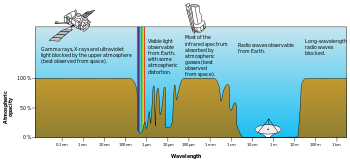Radio waves
Radio waves are a type of electromagnetic radiation with wavelengths in the electromagnetic spectrum longer than infrared light. Like all other electromagnetic waves, they travel at the speed of light. Naturally-occurring radio waves are made by lightning, or by astronomical objects. Artificially-generated radio waves are used for fixed and mobile radio communication, broadcasting, radar and other navigation systems, satellite communication, computer networks and innumerable other applications. Different frequencies of radio waves have different propagation characteristics in the Earth's atmosphere; long waves may cover a part of the Earth very consistently, shorter waves can reflect off the ionosphere and travel around the world, and much shorter wavelengths bend or reflect very little and travel on a line of sight.

Diagram of the electric (E) and magnetic (H) fields of Radio Waves emanating from a grounded radio transmitting
antenna (small dark vertical line in the center). The E and H fields are perpendicular as implied by the phase diagram in the lower right.
Discovery and utilization
Radio waves were first predicted by mathematical work done in 1865 by James Clerk Maxwell. Maxwell noticed wavelike properties of light and similarities in electrical and magnetic observations. He then proposed equations, that described light waves and radio waves as waves of electromagnetism that travel in space. In 1887, Heinrich Hertz demonstrated the reality of Maxwell's electromagnetic waves by experimentally generating radio waves in his laboratory.[1] Many inventions followed, making practical the use of radio waves to transfer information through space.
Propagation
The study of electromagnetic phenomena such as reflection, refraction, polarization, diffraction and absorption is of critical importance in the study of how radio waves move in free space and over the surface of the Earth. Different frequencies experience different combinations of these phenomena in the Earth's atmosphere, making certain radio bands more useful for specific purposes than others.
Radio communication
In order to receive radio signals, for instance from AM/FM radio stations, a radio antenna must be used. However, since the antenna will pick up thousands of radio signals at a time, a radio tuner is necessary to tune in to a particular frequency (or frequency range).[2] This is typically done via a resonator (in its simplest form, a circuit with a capacitor and an inductor). The resonator is configured to resonate at a particular frequency (or frequency band), thus amplifying sine waves at that radio frequency, while ignoring other sine waves. Usually, either the inductor or the capacitor of the resonator is adjustable, allowing the user to change the frequency at which it resonates.[3]
In medicine
Radio frequency (RF) energy has been used in medical treatments for over 75 years[4] generally for minimally invasive surgeries and coagulation, including the treatment of sleep apnea.[5]
See also
References
- ↑ Heinrich Hertz: The Discovery of Radio Waves
- ↑ Brain, Marshall (2000-12-07). "How Radio Works". HowStuffWorks.com. http://electronics.howstuffworks.com/radio8.htm. Retrieved 2009-09-11.
- ↑ Brain, Marshall (2000-12-08). "How Oscillators Work". HowStuffWorks.com. http://electronics.howstuffworks.com/oscillator3.htm. Retrieved 2009-09-11.
- ↑ Ruey J. Sung and Michael R. Lauer (2000). Fundamental approaches to the management of cardiac arrhythmias. Springer. p. 153. ISBN 9780792365594. http://books.google.com/?id=S1fWhl2c5zIC&pg=PA153&dq=rf+coagulation+75-years.
- ↑ Melvin A. Shiffman, Sid J. Mirrafati, Samuel M. Lam and Chelso G. Cueteaux (2007). Simplified Facial Rejuvenation. Springer. p. 157. ISBN 9783540710967. http://books.google.com/?id=w1fQK21WK28C&pg=RA1-PA157&dq=rf+coagulation+sleep-apnea.
|
Radiation (Physics & Health) |
|
| Main articles |
|
|
| Radiation health effects |
Radiation therapy · Radiation poisoning · Radioactivity in biological research · List of civilian radiation accidents
Mobile phone radiation and health · Wireless electronic devices and health · Health physics · Laser safety · Lasers and aviation safety
|
|
| Related articles |
|
|
| See also: Category:Radiation effects · Category:Radioactivity · Category:Radiation health effects · Category:Radiobiology |
|

